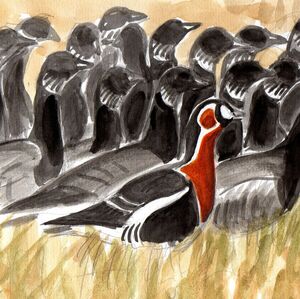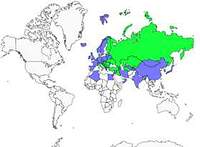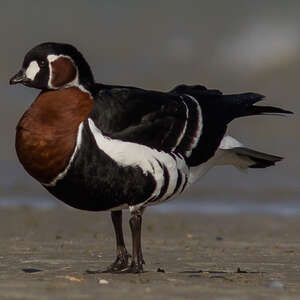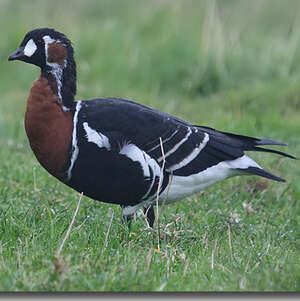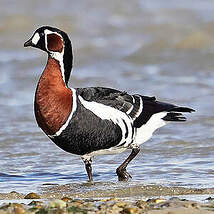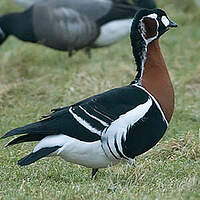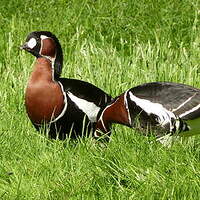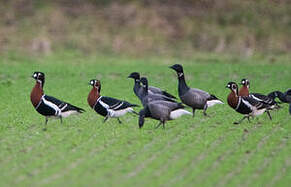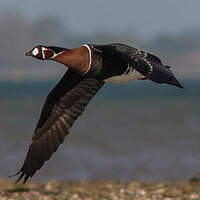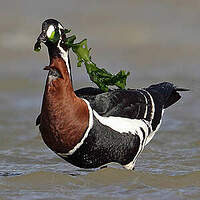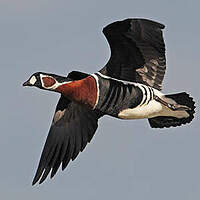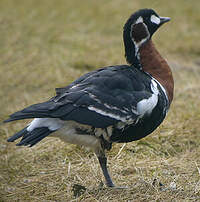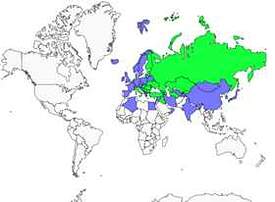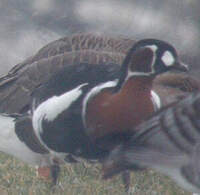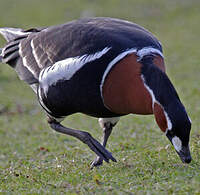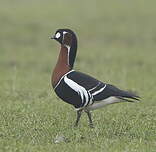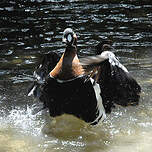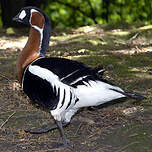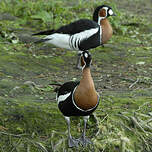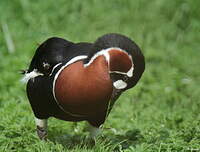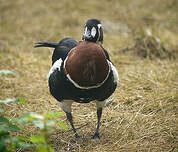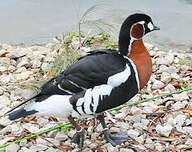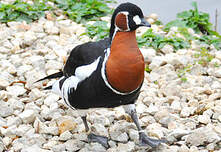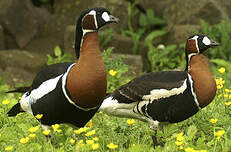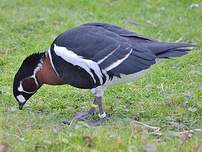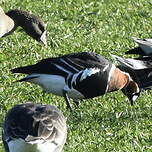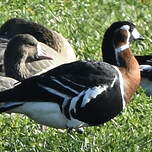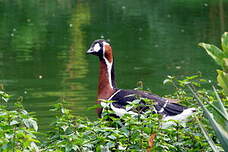Red-breasted Goose
Branta ruficollis - Bernache à cou roux
Identification
The plumage of the Red-breasted Goose makes it easily recognizable due to its reddish, black, and white feathers. The adult has a black back, forebreast, upper head and nape. A white oval patch is between the eye and the bill. The eyes are dark brown with reddish cheeks surrounded by a white border extending downward to the neck. The neck and breast are also reddish red. The breast is separated from the rest of the body by a thin white band. A large white band is visible on the flank. Two distinct white bars are on the closed wing. The belly and undertail are white and the legs and short bill are black. Male and female are not dimorphic, except for the larger size of the male. The female is sometimes a bit more muted.
Juveniles are more muted with less defined areas. The reddish area of the cheeks is reduced and four to five narrow transverse white bands can be seen on the closed wing.
Newly-born are dark brown above and white below.
Subspecific information monotypic species
Foreign names
- Bernache à cou roux,
- Barnacla cuelliroja,
- ganso-de-peito-ruivo,
- Rothalsgans,
- vörösnyakú lúd,
- Roodhalsgans,
- Oca collorosso,
- rödhalsad gås,
- Rødhalsgås,
- bernikla červenokrká,
- berneška rudokrká,
- Rødhalset Gås,
- punakaulahanhi,
- oca de coll roig,
- Fagurgæs,
- bernikla rdzawoszyja,
- sarkankakla zoss,
- rdečevrata gos,
- Краснозобая казарка,
- アオガン,
- 红胸黑雁,
- 紅胸黑雁,
Voice song and call
Habitat
The Red-breasted Goose nests in the tundra of northern Siberia. It can be found near water, on grassy banks. It winters in the southeastern steppes of Europe, on the shores of the Black Sea, the Caspian Sea, and the Aral Sea. In winter, it is mostly found near lakes, reservoirs, and marshes. In wintering its range is much farther away from aquatic areas.
Behaviour character trait
The Red-breasted Goose typically builds its nest near an area inhabited by a Peregrine Falcon, a northern bustard or an eagle owl, providing it with protection against foxes and minks.
Up to five pairs of these geese can occupy the same territory protected by these larger birds. Post-nuptial migration occurs in September while pre-nuptial migration starts in February and goes until June when they return to their breeding grounds. Migration usually occurs in large flocks, often mixed with a flock of laughing geese who share the same pasturing areas. The much larger laughing geese usually alert the group of any danger. When not disturbed, they only move away several hundred metres from the shore to graze. During extreme cold, they huddle together to keep warm and a flock can reach several thousand birds. It is a very gregarious bird. Like most Anatidae, they sleep in the water during the night and graze on land during the day.Flight
Dietfeeding habits
Reproduction nesting
In June, nest building begins on a slope or cliff. It is shallow and lined with dried grass and down feathers.
The female lays 4 to 5 eggs, cream-colored, 71 x 49 mm and weighing 76 g, which she incubates alone for about 23 to 25 days. The male, on the other hand, stands guard near the nest. Births are synchronized and the chicks leave the nest shortly after birth and can follow their parents in their movements. At the age of forty days, the full plumage has completely replaced the down. The parents continue to take care of the young until they are 3 or 4 years old, the age of their sexual maturity. In years when lemmings are numerous, the breeding season of the Red-breasted Goose is better, as predators have a preference for this animal and then leave the eggs and chicks alone. The couples have very strong and permanent links.Geographic range
This species nests in the tundras of northern Russia, more precisely in the Taymyr, Gydan, and Yamal Peninsulas. Since the 1940s, it has shifted its wintering grounds to southeastern Europe, mainly Romania, Bulgaria and Ukraine. It also appears irregularly and in small numbers in Hungary, Greece, and Turkey. Its total population is around 70,000 individuals. 30,000 to 40,000 Red-breasted Geese spend the winter in Romania, representing the majority of the world population.
Threats - protection
IUCN conservation status
concern
in the Wild
threatened
evaluated
Over the last ten years, the Red-breasted Goose has suffered a 56% decline in its population. The species is mainly affected by excessive and illegal hunting on wintering grounds as well as drainage of wetlands (cultivation). Oil exploration and climate change are threatening nesting areas.
Sources of information
- IOC World Bird List (v14.2), Gill, F and D Donsker (Eds). 2024-04-18.
- Guide des canards, des oies et des cygnes, Steve Madge
- Guide des oiseaux de France et d'Europe, Roger Tory Peterson, Guy Mountfort, P. A. D (Phill
- Le guide ornitho : Le guide le plus complet des oiseaux d'Europe, d'Afrique du Nord et du Moyen-Orient : 900 espèces, Svensson, Mullarney, Zetterstrom
- Avibase, Lepage Denis
- BirdLife International, BirdLife International
Other sources of interest
 Specification sheet created on
02/08/2023 by Jean-Pierre Trouillas
Specification sheet created on
02/08/2023 by Jean-Pierre TrouillasTranslation by AI Oiseaux.net
© 1996-2025 Oiseaux.net
- Accipitriformes
- Aegotheliformes
- Anseriformes
- Apodiformes
- Apterygiformes
- Bucerotiformes
- Caprimulgiformes
- Cariamiformes
- Casuariiformes
- Charadriiformes
- Ciconiiformes
- Coliiformes
- Columbiformes
- Coraciiformes
- Cuculiformes
- Eurypygiformes
- Falconiformes
- Galliformes
- Gaviiformes
- Gruiformes
- Leptosomiformes
- Mesitornithiformes
- Musophagiformes
- Nyctibiiformes
- Opisthocomiformes
- Otidiformes
- Passeriformes
- Pelecaniformes
- Phaethontiformes
- Phoenicopteriformes
- Piciformes
- Podargiformes
- Podicipediformes
- Procellariiformes
- Psittaciformes
- Pterocliformes
- Rheiformes
- Sphenisciformes
- Steatornithiformes
- Strigiformes
- Struthioniformes
- Suliformes
- Tinamiformes
- Trogoniformes

